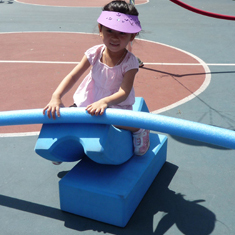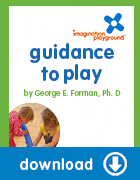All of the parts can be moved, but some parts can rock or roll or pivot in predictable ways.
These movements add function to the form.

Young girl discovers that an Arch Chute upside down makes a great rocking horse. To sustain her interest she will probably pretend to be riding a horse or a rocking boat.

Using the Little Cheese and Plug parts, this boy made a car. The wheels turn as he pushes the car forward with his feet. This car is an advanced use of moving parts since the structure more than looks like a car; it works like one as well.
What It Means
A gear on a cylinder becomes more than a look-alike flower. It can rotate and become a grinder. When children add function to form they begin to see the form in increasingly creative ways. Consider a hinged block that moves in a wall as a door. Compared to an open hole in the wall, the open door means, “I am open now but I could close at any time.” An open door is a special opportunity to enter, more so than an open hole that is always open. Since the closed door looks like a solid wall, the child can pretend it is a secret passage. The potential movement of parts adds interest and story to the child’s play.
2-4 Year Olds
At the youngest ages, children will be more alert about how single objects move, the rolling wheel and plugs, the rocking chute, and making the noodles bend back and forth.
4-7 Year Olds
The next stage could be simple joints that create new composite forms but are not played with or talked about as a moving joint, such as putting plugs in holes to make arms for a robot or two hinges joined to make an adjustable A-frame peak. The part movements are used more for quick changes in the structure’s shape rather than to do work.
7-10 Year Olds
As children get older and work more with the blocks, they will invent simple machines or animals with moving parts, such as a neck that moves for a grazing giraffe or wheels that roll across the ground. The movements have a function, a purpose (pretend or real) beyond simply providing a convenient way to change the shape of the structure.
This material is adapted from the publication “Imagination Playground’s Guidance to Play” by George E. Forman, PhD, Emeritus Professor, University of Massachusetts (Amherst) and President of Videatives, Inc.
Dr. Forman has over 33 years of experience in university teaching, cognitive research, multimedia design and educational consulting in the area of early childhood learning and development.
“Guidance to Play” covers 20 topics that help illustrate the significance in what children are doing as they play as well as concrete actions Play Associates can take to facilitate positive behaviors.



